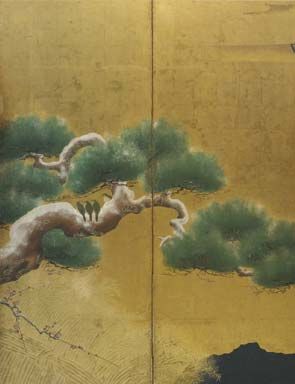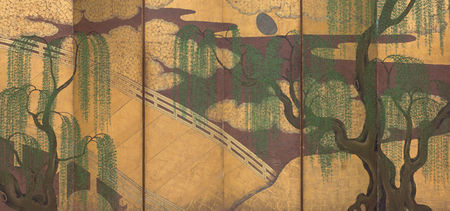Beyond Golden Clouds: Japanese Screens from the Art Institute of Chicago and the Saint Louis Art Museum
Kano Koi (Japanese, c. 1569-1636). Pheasant and Pine, c. 1626. Six-panel screen; ink, colors, and gold on paper; 170.2 x 380 cm. Saint Louis Art Museum, Funds given by Mary and Oliver Langenberg, Mr. and Mrs. Richard A. Liddy, and Susan and David Mesker (105.2002). (Detail)
CHICAGO, IL.- The Art Institute of Chicago and the Saint Louis Art Museum have collaborated on a major exhibition that showcases the rarely seen masterpieces of Japanese screens from both museums' permanent collections. Beyond Golden Clouds: Japanese Screens from the Art Institute of Chicago and the Saint Louis Art Museum--on view at the Art Institute's Regenstein Hall from June 26 through September 27, 2009 --reveals the delicate dynamism of the screen format, its lasting significance in Japan, and its consistent appeal around the world. The exhibition, which will be shown at both museums, will include 21 of the most important screens or pairs of screens from the Art Institute and 13 from the Saint Louis Art Museum. Due to their fragility and sensitivity to light, these screens are rarely seen in such a large presentation. To protect them, the works will be featured at the Art Institute in two rotations, one that begins on June 26 and a second installation that begins on August 15.
The Japanese screen, or byobu , has been an object of perpetual fascination in the West since Europeans had their first glimpse of these expansive, folding paintings in the sixteenth century. Part utilitarian object and part creative expression of the highest order, Japanese screens, then as now, connote status as well as aesthetic sensibility and, because of their uniqueness, have come to symbolize Japan itself. Yet despite the long-held interest in screens, scholarship regarding the form has been almost silent on the role of the screen as an object--that is, a freestanding, framed partition usually meant to be viewed folded. Unlike any other painting format in Japan, the production of a folding screen carries with it particular compositional concerns resulting from the use of hinged panels and from its fusion of painting and craft techniques for the surface, brocade borders, lacquer frames, and metal fixtures. Byobuhave also had a wide range of important functions--from displays at special occasions to their integral roles in larger decorative programs at specific locations to their use as luxury gifts.
Beyond Golden Clouds offers a comprehensive view of the art of the folding screen: the place of screens as functional works of art; their characteristic materials and painting techniques; their development in Japan and collection in the West; and their influence on the art of other cultures. The exhibition also examines the "world within the screen": the representation by Japanese artists of the country's tradition and culture as well as the worlds of fantasy, literature, the sacred, and the foreign. Because their size allows for artists to create sweeping visions, larger than those in most other painting formats, the screens occupy a distinctive position in Japanese culture, also examined in the exhibition.
Unlike exhibitions of Japanese screens in the past, Beyond Golden Clouds includes a range of works from pre-Meiji era (1868-1912) ink paintings to modern day installation pieces. This exhibition celebrates the possibilities of the screen format in a way only the collaboration of the Art Institute of Chicago and the Saint Louis Art Museum could achieve, drawing as it does on the Art Institute's strength in decorative and iconic screens of the 17th century and Saint Louis's pivotal calligraphic screens and contemporary works. In terms of media, Beyond Golden Clouds is unprecedented in its inclusion of traditional works on paper or silk alongside contemporary screens made up of ceramic panels and varnished panels resembling lacquer.
Highlights of Beyond Golden Clouds include a pair of screens depicting a bustling ink landscape by Sesson Shukei (c.1490-after 1577), the earliest work on display. Willow Bridge and Waterwheelby Hasegawa Soya is a tour de force of the art of the folding screen, produced during the format's golden age in the seventeenth century. Representing the screen's modern and contemporary eras are Yamakawa Shuho's entrancing Relaxing in the Shade of 1933 and Kayama Matazo's powerful Star Festival of 1968. Morita Shiryu's Dragon Knows Dragonmakes use of nontraditional materials; it is a calligraphic work in which the characters appear in gold on a black surface that shines with the finish of lacquer.
Hasegawa Soya. Willow Bridge and Waterwheel (detail), c. 1650. Kate S. Buckingham and Frederick W. Renshaw endowments.
Ikeda Keisen (Japanese, 1863-1932). Fish and Plants, 1908. Single six-panel screen; ink, color, and gold on silk; 137 x 287 cm. President’s Exhibition and Acquisition Fund; Alsdorf Discretionary Fund; Russell Tyson Endowment Fund; Purchased with Funds Provided by the Wetson Foundation

/https%3A%2F%2Fprofilepics.canalblog.com%2Fprofilepics%2F1%2F0%2F100183.jpg)
/https%3A%2F%2Fstorage.canalblog.com%2F03%2F02%2F119589%2F96711876_o.jpg)
/https%3A%2F%2Fstorage.canalblog.com%2F11%2F31%2F119589%2F94773502_o.jpg)
/https%3A%2F%2Fstorage.canalblog.com%2F20%2F83%2F119589%2F94772815_o.jpg)
/https%3A%2F%2Fstorage.canalblog.com%2F26%2F72%2F119589%2F75604929_o.jpg)
/https%3A%2F%2Fstorage.canalblog.com%2F59%2F60%2F119589%2F26458628_o.jpg)





/http%3A%2F%2Fstorage.canalblog.com%2F60%2F81%2F119589%2F70307138_o.jpg)
/image%2F1371349%2F20240426%2Fob_dcd32f_telechargement-32.jpg)
/image%2F1371349%2F20240426%2Fob_0d4ec9_telechargement-27.jpg)
/image%2F1371349%2F20240426%2Fob_fa9acd_telechargement-23.jpg)